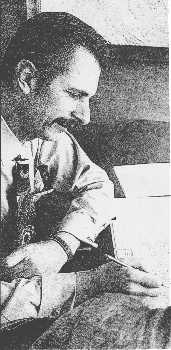

 Dave Cochran, Model 35 project leader |
 Tom Whitney, project manager for the Model 35 |

Arithmetic: Add, subtract (60 ms); multiply, divide (100 ms): square root (100 ms).Display --
Trigonometric: sin x, cos x, tan x, arc sin x, arc cos x, arc tan x (500 ms).
Logarithmic: log10 x, ln x, e x (200 ms).
Other: x y (400 ms); 1/x: PI; plus data storage and positioning keys.
(There is an operational stack of four registers, and a memory register for constants. The stack holds intermediate results and, at the appropriate time, automatically recalls them for further processing. This eliminates scratch-pad notes and reentry of intermediate answers. Any register can be shifted to the display for review.)
Ten significant digits with the decimal point automatically positioned. Numbers larger than 10 ^ -2 and smaller than 10 ^ 10 are automatically displayed in floating point. Outside this range, numbers are expressed in scientific notation, with two-digit powers of ten shown at the extreme right. Trailing zeros are automatically blanked. A flashing display indicates an improper operation.Power source --
Rechargeable NiCad batteries, 500 mW; or 115/230 Vac, +/- 10%, 50-60 Hz, 5 W.Operating temperature range --
0 to 40C. Size --
3.2 x 5.8 x 1.3 (max.) inches.Weight --
9 oz. (calculator with batteries).Price --
$395, including ac adapter, battery recharger, soft leather case, travel case, operating manual, and owner name-tags.